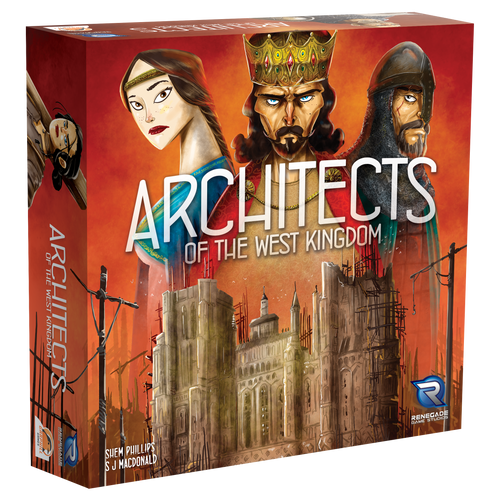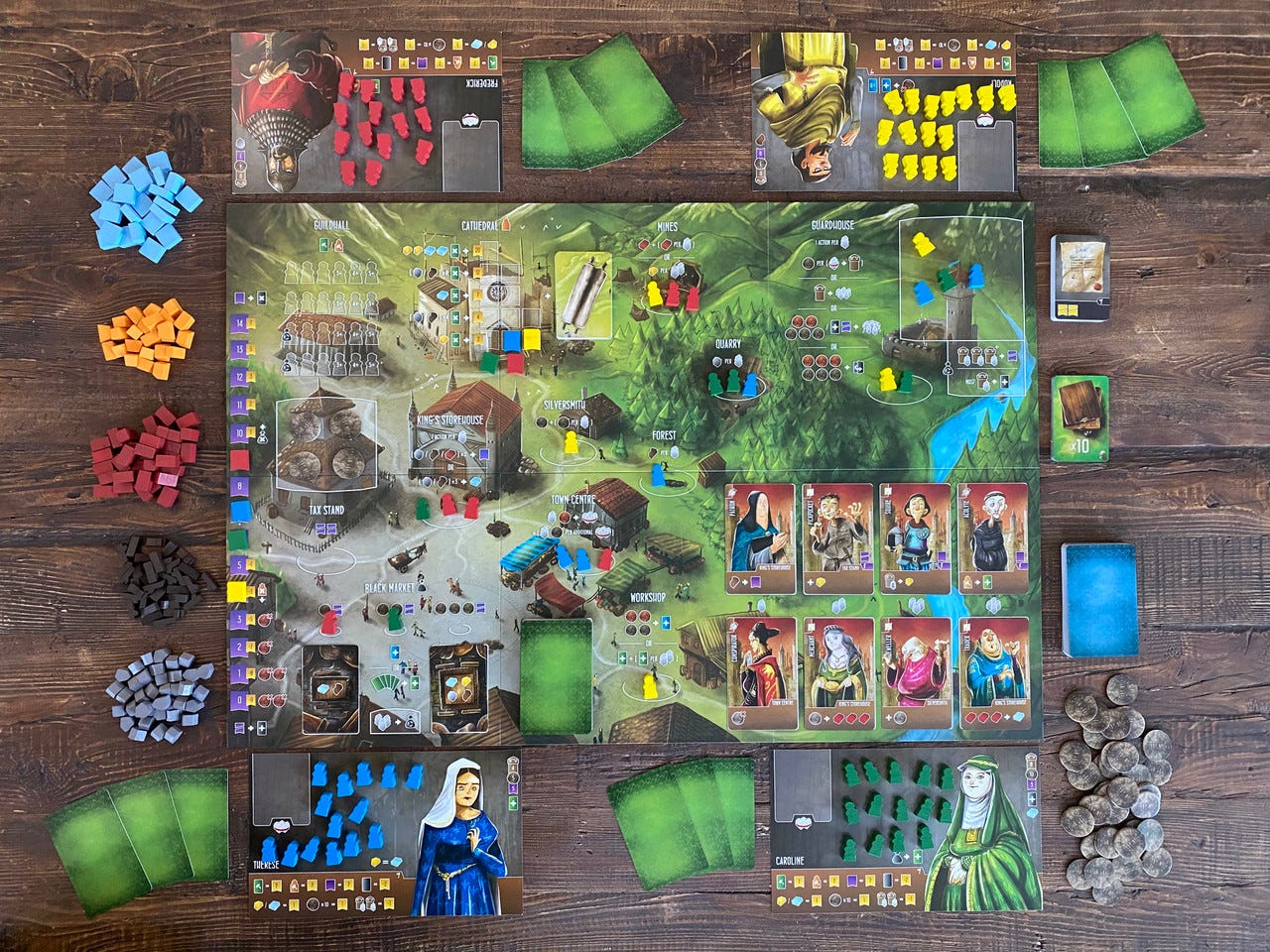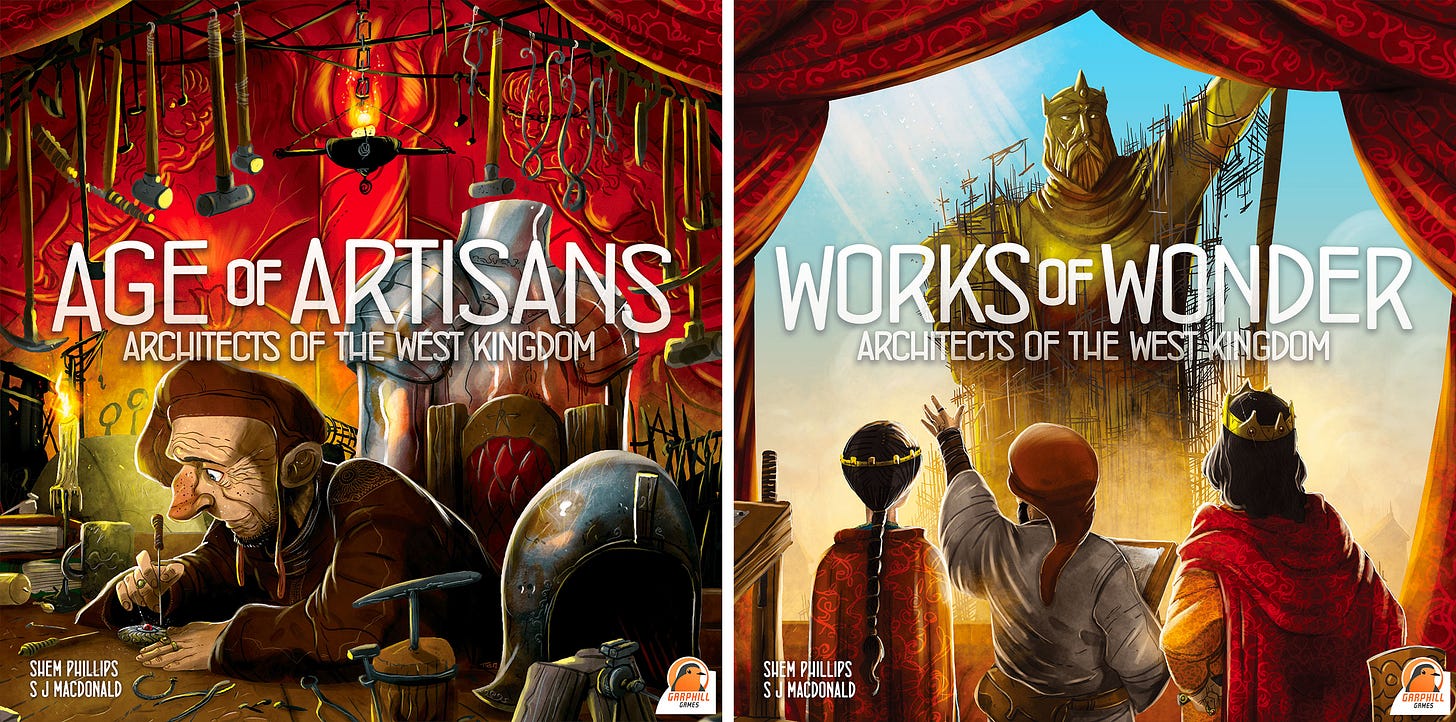Board Game Review - Architects of the West Kingdom
Cathedrals everywhere for those with eyes to see
If you’ve played any number of worker placement games, you’ve probably noticed that they’re generally pretty low on player interaction. Games like Agricola, Lords of Waterdeep, or Champions of Midgard really don’t have a whole lot of ways to mess with other players beyond simply taking spaces they might’ve wanted. Architects of the West Kingdom from Garphill games puts a really clever spin on the typical worker formula by providing a litany of “take-that” opportunities while still remaining a pretty straightforward worker game.
I’m going to say something up front here, which is that I wholly recommend picking up this game as long as you grab one of the expansions — I’ll get into more specifics about why later on, but I think this is one of those games that really benefits from the changes made therein. First, though, let’s discuss the basics. The central conceit of Architects is, predictably, building stuff. You’ll be placing workers to gather resources, grab cash, and hire craftsmen to either build building cards in front of you, or advance your marker up the cathedral. Along the way you might engage in some shady activities like collecting taxes or buying from the black market, which at a minimum might deny you extra victory points or action options, but at worst could land you in jail.
There’s a couple of interesting things Architects does out of the gate. First and foremost, the vast majority of spaces on the board aren’t limited to a single worker — indeed, many spaces actually get better for you the more workers you have on them. So, the first time you gather wood you’ll only get one, but the next time you’ll be able to pick up two, etc. Very quickly, you’ll find yourself with an influx of resources of particular types. These aren’t the only spaces that benefit from having extra workers, though. At some locations, like the storehouse and the prison, you’ll get to take one action per worker you have on that space, and at others the action you take will change, like being able to hire a different selection of craftsmen or being able to pick up gold instead of clay.
There is, of course, a catch. At some point, you’re going to find yourself running out of workers, or more likely you’ll decide that the player across from you is getting a bit too much stone for your liking. At one particular space on the board, you can spend a nominal fee to select a space and scoop up all the workers of one color — if they’re yours, they just go back in your collection, but if they belong to someone else, you get to put them on your board. And — guess what — if you’ve got multiple actions, you can pick up additional colors of workers. Once you’ve got them on your board, the player who owns them will have to spend a turn and a large pile of money to free them, but you can also drop them off at the prison for a hefty payout.
In this way, Architects incentivizes you to get nasty — there are few other ways to get massive influxes of cash all at once, and if you don’t keep your fellow players in check they’ll quickly start to run away with all the resources they need. The “Virtue” track on the side of the board keeps track of how upstanding you are as a citizen, and it’s important to keep an eye on it. The black market locations make it really easy to pick up rare resources like gold and marble — resources you’ll need plenty of to build on the cathedral — but every time you visit them, you’ll lose Virtue points. If you get too low, you’ll be barred from building on the cathedral. Conversely, if you do build on the cathedral (or certain building cards), you’ll move up on the Virtue track. This is good, because if you get high enough you’ll earn extra points at the end of the game, but if you get too high, you’ll be barred from using the black market spaces. A delicate balancing act, indeed!
Unfortunately, the balance is pretty skewed, here. In the base game, it’s pretty common for whoever got to the top of the cathedral track to blow everyone else out of the water, score-wise. The other buildings are just a little too difficult to build enough of, and while getting thrown in jail can mess up your chances at getting important resources for building cards, it doesn’t really matter as much for the cathedral since those resources will generally be found elsewhere, anyway. There is a sort of self-regulating effect the game has to reset its cadence, though, with the “black market resets.” Every time a certain number of build actions are performed, or every time the black market spaces fill up, you’ll send the workers there to jail and distribute point-destroying Debt cards to the people that have too many workers in jail. This usually winds up negatively impacting anyone who is low on the Virtue track especially — crime doesn’t pay!
While I think the base game makes it too easy to win if you build on the cathedral — and incentivizes you to do so with the resource costs, extra bonus cards you get for building there, and the inherent difficulty of building cards thanks to the high resource costs and requirement for craftsmen (which the cathedral doesn’t need, either), most of these problems are resolved by the game’s two expansions.
The Age of Artisans expansion adds, well, artisans — fancy new workers with the unique ability to count as two workers when placed and also avoid losing Virtue. It also adds important new cards in the Adornments and Tools, which can either supercharge your constructed building cards, or give your craftsmen extra utility, both of which incentivize building using cards rather than just the cathedral. The Works of Wonder expansion improves the balance even further, by adding new “wonder” structures that require huge amounts of one particular resource and yield a boatload of points, as well as the “princess” and “profiteer”. These are two new tokens that move around the board and will give you extra bonuses or penalties when you visit their spaces, encouraging you to be a bit more exploratory with where you put your workers.
I think these two expansions together transform Architects from a good game into a great one (and they also increase the player count up to six, too). On its own, it’s a fun worker game with some nice opportunities for nastiness and only one real path to victory. Once you add the expansions, though, it kicks into high gear, with lots of different avenues to pursue, ways to upgrade the cards you’ve collected, and decisions to make about what to build and when. Plus, there’s still a lot of ways to be mean to each other. What more could you want?




